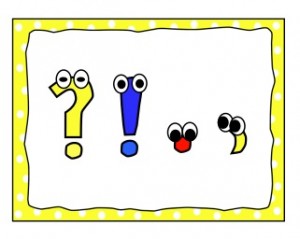In the first post of our multi-part proofing series, we shared our personal proofreading techniques. For all future posts in this series, we’ll discuss the most common writing mistakes that we encounter. Besides, when proofing, it’s good to know what you’re looking for when you publish writing that doesn’t go through the cj content team.
The majority of mistakes that we see here in Creative Services involve punctuation. And I must say that the most egregious punctuation crimes involve the comma! Well, we’re here to break the cycle of comma abuse.
Punctuation Saves Lives!
The misuse of the comma and any other punctuation can completely change the meaning of your brand’s messaging and confuse your readers. For example: Let’s eat Arnie Malham. That sounds terrifying! Try this: Let’s eat, Arnie Malham. See? That comma just saved Arnie’s life. The sentence with the comma told the reader that we want to share a meal with Arnie. The one without the comma indicates that we’d like Arnie with fava beans and a nice Chianti. See how delivering your brand’s message depends on your ability to recognize how to use a comma?
I Got 99 Problems, But a Comma Ain’t One!
So to save more lives (and your brand’s reputation), here are just a few common and correct ways to use the comma:
- Use commas to separate independent clauses when they are joined by any of these seven coordinating conjunctions: and, but, for, or, nor, so, yet. Joining independent clauses with a comma but without a conjunction results in a comma splice. That’s against the law, or at least it should be. An example of a comma splice is: Sarah writes the lyrics, he writes the melody. Correction: Sarah writes the lyrics, and he writes the melody.
- Use commas after introductory phrases, clauses, or words that come before the main clause. Example: To keep from falling asleep at her desk, Dana drank espresso and slapped her own face.
- Use commas to separate three or more words or phrases in a series. Example: David likes to watch football, baseball, and mud wrestling. One bit of comma drama associated with this rule involves the Oxford/serial comma. A comma before the “and” is a style choice. We use the Oxford comma around here, but you won’t be judged harshly if you don’t. Just be consistent!
- Use a comma to set off quoted text. For example: “I would like my coffee with cream and sugar, please,” she said politely.
- Use commas before and after nonessential words in a sentence. These words often seem like an interruption. Nonessential information simply provides additional information about your sentence’s subject. Example: My uncle, the one with the mullet, photobombed all of the pictures at the family reunion.
- On the other hand, you never need a comma with essential items. If you wonder how to determine if a clause or phrase is essential or nonessential, leave them out of the sentence. If the sentence makes no sense without the information, it’s essential and doesn’t need commas. The sentence with only its essential elements would read: My uncle photobombed all of the pictures at the family reunion. The mullet is nonessential information (and a tragic fashion choice).
- Use a comma at the end of a sentence to separate contrasting coordinated sections. For example: Carla was a little angry, not enraged.
There are many more rules on comma usage! If you’d like to learn more about how to use the comma correctly and the functions of other punctuation, check out Purdue Owl, Grammarist, or Grammar Girl. And of course, feel free to reach out to cj Copywriter Jenny Madison at jmadison@cjadvertising.com.



